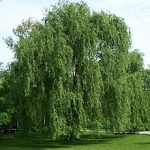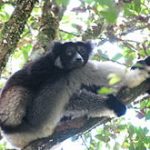TREE LIFE
AUGUST 2011
MASHONALAND CALENDAR
Sunday July 21st Day visit to Ewanrigg Botanical Gardens. It is a long time since we last visited this interesting venue. Please bring chairs, water, hats and a packed lunch. We will meet at the usual time of 09.30.
Directions: It is a long time since we last visited. Take the Enterprise Road out of town and just after the toll gate fork left and follow the road past Enterprise Club toward Shamva. Then look for the sign on the right for Ewanrigg. If you reach Bally Vaughan you have gone too far. Once through the gate, follow the road to the left and drive to the very end, to the tree area at the top, where we shall park. Parks entry fees: $5 per person ($1.50 for pensioners) and $5 per car, plus $2 for the road toll. Car-pooling recommended for economy purposes.
Saturday August 27th. Larmeniere Saturday afternoon walk. . Meet at the clubhouse at 1430 hrs. After the walk, tea and coffee will be provided. Please bring some snacks as a contribution.
WEEKEND AT LA ROCHELLE, PENHALONGA 17TH-20TH JUNE 2011
Eighteen members of the Tree Society from Harare had the pleasure of a long weekend in the Eastern Districts in June. We were joined by five local tree enthusiasts who provided us with valuable local knowledge.
The party stayed at La Rochelle Hotel halfway up the Imbeza Valley, off the Mutare/Penhalonga road. La Rochelle was built in 1951 as a retirement home by Sir Stephen and Lady Virginia Courtauld, a very wealthy English couple. One of their passions was gardening, and they established a botanic garden and an orchid collection. They donated the property to the National Trust in 1970, when they left Zimbabwe, since which time it has had a very chequered career before being taken over as a country hotel under the very capable management of Simon Herring, who was our host for the weekend. The buildings and gardens are sadly run down, but the accommodation is very comfortable, if one can forgive dripping taps and overflowing cisterns, and the food is superb. The weekend was organised by Bill Clarke, who did an outstanding job of keeping us together and entertained in the evenings; we even had a snooker competition.
Mark spent the whole of the Saturday with Nicholas Kashiri, the head gardener, and Terry Martins, identifying and labelling trees in the arboretum for the National Trust. Some members stayed behind to watch and to explore the gardens, while the rest of us spent the morning at the head of the valley, on Imbeza Forest Estate, to look at “real trees”, as opposed to aliens/exotics. We were ably led by Meg and guided by Peter Buttress and John Meikle.
On Sunday morning we all went to Murahwa’s Hill, next to Christmas Pass, a botanical reserve also owned by the National Trust, where we were guided by Darrel Plowes, an eminent local naturalist.
Imbeza Valley, 18th June
The morning was bitterly cold and misty as three car loads of enthusiasts negotiated a very dusty road up through Imbeza Forest Estate to the Mozambique border, at nearly 1600m. Although we had been promised ‘real trees’, most of what we saw was planted eucalypts. As a result, the bird enthusiasts among us had a disappointing day, as birds were very scarce; the cold, gloomy weather didn’t help. The indigenous forest that we had gone to see was restricted to a very steep-sided valley in amongst the plantations, which we could view from the adjacent roads and tracks but which was very difficult to get into. Once in it, the leaves which had seemed tantalisingly accessible from outside were way above the reach of anyone, and nobody had thought to bring a catapult or a gun to shoot them down for examination.
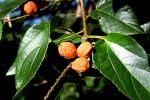
Croton sylvaticus, fruit. Photo: Bart Wursten. https://www.zimbabweflora.co.zw
Nevertheless we had a very interesting walk and saw a number of species that we do not encounter around Harare, some of which puzzled Meg herself. Amongst the tall trees we found Croton sylvaticus, the Forest Croton; Albizia gummifera, the Smooth-bark Flat-crown, which is very popular in gardens in Harare and is the high altitude flat-crowned Albizia, as opposed to Albizia adianthifolia, the Rough-barked Flat-crown, which is usually found below 1000m; Myrianthus holstii, which has distinctive, large, digitate leaves and fruit resembling a miniature pineapple; Polyscias fulva, the Parasol Tree, so-called because of the large pinnate leaves at the top of the long trunk that resemble a sunshade; Craibia brevicaudata, the Mountain Craibia, which has white, sweet pea-like flowers; Xymalos monospora, the Lemonwood, so-called presumably because of its yellow wood; and Sapium ellipticum, the Jumping-seed Tree, so-called because the seeds often become infested with the larvae of a little grey moth, and when the larvae straighten their bodies the seeds jump several centimetres into the air.
The understory plants were more accessible, along the edges of the roads. We found Psychotria zombamontana, the Red Bird-berry, without berries; Macaranga mellifera, the Mountain Macaranga, a very common component of high-altitude forest; Buddleja salviifolia, Sagewood, which is a popular garden plant with white to purple flowers, but not in winter; Oricia bachmannii, the Twin-berry Tree, with trifoliolate leaves that vary from opposite to alternate; Aphloia theiformis, the Albino-berry, so-called because of its white fruit, which we didn’t see but which Meg thought might attract nocturnal feeders, such as Blue Duiker; Halleria lucida, the Tree-fuchsia, which has orange/red tubular flowers (not in winter) that make it an attractive garden plant; Dombeya burgessiae, the Pink Dombeya, quite similar to Dombeya rotundifolia, the Wild-pear, which is common around Harare, but with pink/white flowers and leaves with overlapping lobes at the base; Toddalia asiatica, the Cockspur-orange, a climbing shrub belonging to the citrus family (Rutaceae), the leaves of which smell of citrus oils when crushed; and Mussaenda arcuata, another climber that has very striking star-like flowers.
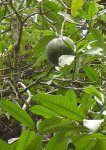
Tabernaemontana stapfiana, fruit. Photo: Bart Wursten. https://www.zimbabweflora.co.zw
John and Peter plunged down the slope into the forest and brought us back leaves of Sclerochiton harveyanus, Blue-lips; Tabernaemontana stapfiana, the Soccer-ball Toad-tree; and Dracaena fragrans, a small member of the Dragon-tree family, which make unusual garden plants, to add to our collection.
In addition to these Eastern Highlands specials we also saw a number of the trees and shrubs that we know from Harare, growing along the roads and probably taking advantage of the disturbed ground to establish themselves, including unwelcome aliens such as Jacaranda, Guava, and a Mexican Apple (Casimiroa edulis) that had us all puzzled until Peter recognised the smell.
Murahwa’s Hill, 19th June
Murahwa’s Hill takes its name from Chief Murahwa, who had a village on its slopes in the 17th and 18th Centuries at the site of a previous San settlement. All that remains of the settlements are stone hut platforms and numerous remnants of pottery and stone tools. The vegetation is very interesting as it changes from medium-altitude rain forest at the base to dry woodland further up. The area was established as a botanical reserve largely as a result of the efforts of Norman Chase, who was a bank clerk in Mutare in the 1950s. He lived in the then Cecil Hotel in town and, after his retirement, walked up to the reserve everyday to oversee its development. Sadly the brass plaque commemorating his contribution has been stolen, and the network of paths that he established through the reserve are mostly impassable because of the thorny vegetation. A caretaker with his two dogs does his best to protect the woodland from wood poachers and keep the carpark and a circular path to the village site open.
The car park itself kept the botanists enthralled for an hour. The first thing that caught our eyes was a large creeper amongst the trees that had small, round, hard-shelled fruit and milky sap, Landolphia buchananii, the Apricot-vine. Strychnos lucens was another climber with small round fruit and paired, curled tendrils. Psychotria kirkii, the Nodule-leafed Bird-berry, is a shrub in the understory with bacterial nodules in lines along the leaves, hence its name. Chaetacme aristata, the Thorny-elm, was widespread; it is very well named because of the sharp spines on the branches. It has glossy green leaves which are very variable, with sharp-toothed or smooth margins and a bristle at the tip. Calodendrum capense, the Cape-chestnut, has long, simple, aromatic leaves and, at the right time of year, striking pink flowers or knobbly, woody fruit. Meg insisted we all look at a small specimen of Bersama abyssinica, the Winged Bersama, to see and remember the wide wings on either side of the rachis of the imparipinnate leaves. Zanha golungensis, the Smooth-fruit Zanha, resembles its relative, Zanha africana, the Velvet-fruit Zanha, which is common around Harare, in that the pinnate leaves cannot decide whether they have a single or paired terminal leaflets; a good label for the genus. We also found an impressive specimen of a strangler fig, Ficus natalensis natalensis, with truncate leaf apices, at the rock where Norman Chases’s plaque should have been; around Harare the other sub-species, F.n.graniticola, a small rock-splitter, is much more common amongst granite boulders.
Once we had left the rain forest for the dry hillside, the vegetation became less exciting, although no less interesting for Mark and Meg. The pace slowed, and most of the party went on ahead to explore the paths. Bilal, Bill and Eva carried on beyond the path to try to reach the top of the hill, but only Bilal succeeded; the dense thorns were too much for the others. Acacia schweinfurthiana was the main culprit; it grew everywhere and formed a very effective barrier to attempts to leave the path and collect specimens. Many of the shrubs and smaller plants were identified only to genus level–Manilkara, Strychnos, Acalypha, Searsia (Rhus), Mimusops–and specimens were collected to take home and work out. Large trees that were not familiar to us around Harare that stood out were Albizia schimperiana, the Forest Long-pod Albizia, and Khaya anthotheca, the Red Mahogany. Other trees present that we know well included Acacia sieberiana, Acacia polyacantha, Kigelia africana and a few aliens, Melia azedarach and Spathodia campanulata included. We also saw a most spectacular show of creamy spiky flowers on top of a big tree that belonged to Phytolacca dodecandra, a succulent climber.
All in all the weekend was a great success, with plenty of interest and good company, and we must thank again Bill Clarke for his good-natured organisation; Simon Herring for the comfortable accommodation, wonderful food, and conjuring tricks; and Mark Hyde and Meg Coates-Palgrave for their patient guidance through the trees of the Eastern Highlands.
– John Lawrence
National Herbarium of Zimbabwe (SRGH)
[Given the Society’s recent success in fund-raising to fumigate the National Herbarium, I felt the membership might be interested in more—albeit a bit dated—information on this good cause. Ed.]The National Herbarium of Zimbabwe (SRGH) is the nucleus of Zimbabwe’s National Herbarium and Botanic Garden, one of 21 institutions within the former Department of Research and Specialist Services, now under the Department of Research and Extension Services in the Ministry of Agriculture. The National Herbarium is located on the western side of the 68ha National Botanic Garden, 4km north of the center of the capital city, Harare.
History
The history of the National Herbarium can be traced to its first accession book, which was opened by Mr H.G. Mundy, who had been appointed as the Government Agriculturist and Botanist in 1909. By 1923, when F. Eyles was appointed Mycologist and Botanist, the herbarium had 3,250 specimens, mainly from farmers and staff of the Department of Agriculture. Eyles had a private herbarium of some 9,000 specimens and had published his Record of Plants Collected in Southern Rhodesia in 1916. When Hiram Wild was appointed to the post of Systematic Botanist in 1945, the herbarium collection had grown to 11,000 specimens.
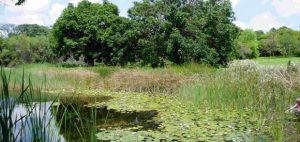
National Botanic Garden Lake
Wild’s era was a period of great botanical achievements in Zimbabwe. He started the Flora zambesiaca project, as well as Kirkia, the Zimbabwe Journal of Botany. Wild also led various collecting expeditions within and outside Zimbabwe. When he left for the University of Zimbabwe in 1966, the herbarium contained 160,000 specimens. R.B. (Bob) Drummond succeeded Wild.
The single-storey building that houses the herbarium today was constructed in 1963. Before October 1963, the specimens were kept in the Harare Research Station. At that time, the herbarium was part of the Plant Protection Research Institute, then known as the Branch of Botany and Plant Pathology. Over the years, the herbarium has been known by various names that reflect the political history of Zimbabwe. From 1909 to 1923, the herbarium was known as the Southern Rhodesia Department of Agriculture Colonial Herbarium. This name was changed to Southern Rhodesia Government Herbarium (the acronym SRGH is derived from this name) in 1923, when Southern Rhodesia was granted self-government by Britain. With the advent of the Federation of Rhodesia and Nyasaland in 1953, the name was again changed to Federal Herbarium, Salisbury. At independence in April 1980, it became known as the National Herbarium of Zimbabwe.
Collections
With over 500,000 plant specimens, SRGH is the largest herbarium in the Flora zambesiaca region (Zimbabwe, Zambia, Malawi, Mozambique and Botswana). Within southern Africa, it shares second place with Compton Herbarium (NBG). Pretoria (PRE) is first, and has a collection of over 1,2 million specimens.
The main vascular plant collection is arranged according to the Englerian system of de Dalla Torre and Harms; the Poaceae—which comprises more than 10% of the total collection—is arranged according to Clayton and Renvoize. Specimens are housed in a mixture of wooden and metal cupboards. The herbarium also maintains algae and bryophyte collections.
SRGH has over 2,000 type specimens and about 21,000 species of vascular plants. About 6,000 of these species are of Zimbabwean origin; the rest are mainly from other African countries, in particular those countries within the Flora zambesiaca region.
Activities
SRGH provides a range of services: Plant Identification Service; Plant Advisory Service; Vegetation Surveys; Publications; Taxonomic Research
Plant Identification Service
The plant identification service can be described as the major service provided by the herbarium staff. Plants are identified free of charge for the general public, consultants, students, governmental and non-governmental institutions.
Plant Advisory Service
The plant advisory service is closely linked to the plant identification service, but differs in that some clients require more than a plant name—they need information on other attributes such as uses, distribution, chemical properties, and toxicity, or advice on whether to allow the importation of certain plants.
Vegetation Surveys
Vegetation surveys are undertaken by staff in response to requests from various clients, such as Government and Non-Governmental Organisations, university departments, departments, researchers, and consultants. The costs are largely borne by the client.
Publications
The National Herbarium produces and distributes literature on the flora of Zimbabwe in the form of books, pamphlets, and brochures. It also publishes Kirkia, the Zimbabwe Journal of Botany. Current projects include Checklist of Zimbabwean vernacular plant names, Checklist of vascular plants of Zimbabwe, Threatened plants of Zimbabwe, Endemic plants of Zimbabwe, and Flowering and fruiting periods of plants in Zimbabwe.
Taxonomic Research
Very little taxonomic research emanates directly from SRGH; the institute mainly acts as a facilitator in taxonomic research by making its collections available to other taxonomists, both within and outside Zimbabwe. Almost all taxonomic research from the staff of SRGH has so far been undertaken as part of academic studies. Recent studies include Commelinaceae, Colchicaceae, Dryopteridaceae, Dracaenaceae, and Restionaceae.
– Nozipo Nobanda SABONET News 6.2:126
GLOBAL FOREST PLAN COULD BOOST FIGHT AGAINST POVERTY AND CLIMATE CHANGE
An emerging initiative could pave the way for fundamental change in the way forests are managed, boosting efforts to fight both poverty and climate change, says research published by the International Institute for Environment and Development (IIED).
The World Bank-nurtured idea is of a global forest partnership that links local and global processes and promotes decision-making on the international stage that reflects the view and needs of local stakeholders such as forest dwellers.
But the study’s authors warn that the World Bank will have to heed the advice of hundreds of experts they consulted if it is to make a real breakthrough in tackling the problems of past decades and the weaknesses of typical international forest programmes.
IIED consulted widely on the Bank’s idea. More than 600 forest experts responded to IIED’s survey or participated in focus groups in Brazil, China, Ghana, Guyana, India, Russia and Mozambique, as well as at international meetings.
A majority agreed a new partnership was needed to protect forests and forest-based livelihoods, but pointed out ways it should diverge from the Bank’s initial idea if it is to really serve local needs on an equitable basis with the rapidly changing global forestry agenda. IIED also reviewed more than 50 existing initiatives to identify the proposed alliance’s potential partners and the gaps it could fill.
The consultation identified key features that would make a global partnership a unique and truly progressive way for international forestry to work. It should focus on empowering primary ‘stakeholders’ such as forest dwellers so that their rights, knowledge and needs are centre-stage. It should greatly improve flows of finance to activities that support local needs alongside global public goods such as carbon storage. It should interact effectively with other sectors such as water and agriculture, where the underlying causes of forest problems – and the seeds of sustainable solutions – are often lodged.
“Without these building blocks, the ambitious partnership idea is unlikely to succeed,” says IIED’s Steve Bass, the report’s co-author. “This is a new opportunity to develop an empowering, stakeholder-focused partnership that can attract real investment to manage forests sustainably. It has potential to harness an enormous groundswell of energy to manage forests so they can help address local poverty and global climate change. Right now, Western governments are planning large climate and forest funds – the partnership could identify the best ways to invest those funds for long-term good.”
Existing efforts to make forestry work for the poor have not generated the results expected. The desire to create a new global forest partnership that connects local and global processes and people is an ambitious break from tradition that could create new ways to do business in the forest sector.
“The World Bank should be praised for breaking with normal practice and supporting the independent scrutiny of its plans through engagement with a broad range of stakeholders,” says co-author James Mayers, head of IIED’s Natural Resources Group. “What the Bank must now avoid is trying to drive the partnership from the top-down. Instead it must act as the facilitator, providing financial and other support in a hands-off way to enable an independent alliance to be built from the bottom up, bringing together local and regional partners with global organisations.”
The report urges the formation of a ‘development group’ of forest, environment and development leaders, mainly from the South and credible to government, civil society and the private sector, who can come together and contribute to the development of the initiative. They would be supported by a small group of progressive international institutions in their efforts to forge a new kind of local-global partnership.
Daniela Gomes Pinto and Mario Monzoni of the Getulio Vargas Foundation, who helped to coordinate the extensive consultation process in Brazil say: “The Brazilians we consulted said a global forest partnership is needed to raise the overall profile of forests, to curb the drivers of deforestation, and to support those who wish to practice sustainable forest management. It must be globally-designed, but country-driven – a partnership for the world, not the World Bank.”
Welcoming the report, the World Bank’s Forest Advisor, Gerhard Dieterle says: “The World Bank is happy to hear there is consensus on a new approach from a broad variety of forest stakeholders from around the world.”
“We have listened to the advice of the hundreds of people consulted and will be following IIED’s recommendation that the World Bank support an independent process of a global partnership growing from the ‘bottom up’,” he says. “We are convinced that this is a lasting way to have forests contribute to economic growth, to the livelihoods of forest-dependent people and poverty reduction as a whole, as well as preserving the global services forests deliver.”
www.iied.org
Book Review
This volume describes nearly 200 herbs, with clear information about preparations, dosages, potential contraindications, and when it is essential to seek a medical herbalist’s advice
Nature’s Medicines: A South African Guide to Herbal Medicines and What They Can Do For You (Published by The Reader’s Digest Association Inc., Heritage Publishing (Pty) Ltd 2006)
The Reader’s Digest has compiled an introduction and practical guide to many southern African plants and their uses in treating illnesses. It includes an alphabetical section listing descriptions of 174 plants and their properties, with easily identifiable images. Not all of the plants are indigenous, however, but this non-specialist book is definitely one that grasps the interest and makes for fascinating reading.
The history of herbalism is covered in the first part of the book, including Eastern and Western herbalism, with explanations and guidelines for safe usage, home cultivation and harvesting and preserving herbs. The “A – Z of Plants” is an alphabetical list of plants and the “A – Z of Ailments” describes more than 130 common illnesses, together with the herbal preparations used to treat them, from Addiction to Urinary Tract and Kidney Problems. Each section includes preparation and dosage, as well as wise cautionary suggestions, for example not to expose oneself to strong sunlight when using figs, because one of the substances in Ficus may induce photosensitization.
For those of us who are interested in natural medication and health without harming other living species, this book is an invaluable asset—educational as well as interesting and inspiring.


